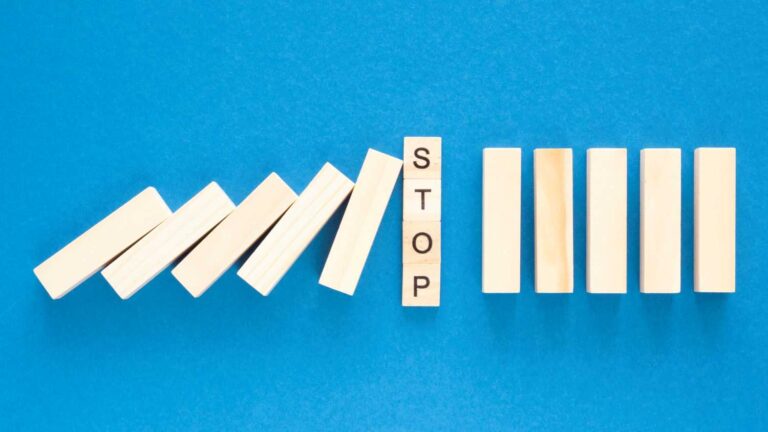Mindset and self-discipline: How thoughts shape actions
Ever notice how some days you can power through your to-do list like a superhero, while other days you can barely get off the couch? Same person, same goals, completely different results.
I used to think my inconsistent discipline was just bad luck or lack of willpower. Some days I had it, some days I didn’t. But after years of working on my own habits, I’ve realized something crucial: it’s not about motivation or even willpower – it’s about the connection between mindset and self-discipline.
Your mindset – the collection of beliefs and thoughts you carry around – isn’t just influencing your discipline. It’s creating it or destroying it before you even take action.
The hidden battle: Your thoughts vs. your actions
Let me share something that changed everything for me. I was trying to establish a consistent morning workout routine. Some days I’d hop out of bed and crush it. Other days, I’d hit snooze five times and skip it entirely.
The difference? It wasn’t my schedule, my sleep quality, or even my motivation level. It was what I was thinking as soon as my alarm went off.
On successful days, my first thought was something like: “Time to get moving – this is what builds strength.” On unsuccessful days, my first thought was: “I’m so tired. I deserve more sleep. I can always work out tomorrow.”
Same situation, different thoughts, completely different outcomes. This is what I want you to really understand – your actions don’t just happen. They follow your thoughts. Every single time.

The 5 discipline-destroying mindsets (and how to transform them)
After years of working on my own mindset, I’ve identified five specific thought patterns that absolutely destroy discipline. These aren’t just occasional thoughts – they’re automatic mental habits that dictate your actions without you even realizing it.
The good news? Once you recognize these patterns, you can change them. Let’s break each one down:
1. The permission-seeking mindset: Waiting to “feel like it”
How it silently controls you:
- “I’ll start when I feel more motivated.”
- “I’m not in the right headspace right now.”
- “I don’t feel like doing it today.”
This mindset puts your feelings in charge of your actions. I struggled with this one for years. I’d only write when “inspiration struck.” I’d only work out when I “felt energetic.” The result? Very little writing and very inconsistent fitness.
Here’s the trap – if you wait until you feel like doing hard things, you’ll be waiting forever. Your feelings will almost always pull you toward comfort, not growth.
The discipline mindset transformation: Replace “I need to feel like it first” with “I act from commitment, not feeling.”
This shift separates your actions from your emotions. It’s not about ignoring your feelings – it’s about recognizing that they’re just weather patterns passing through, not commands you must obey.
How to implement this shift today:
- Catch yourself when you say “I don’t feel like it.”
- Immediately counter with: “My feelings don’t determine my actions.”
- Take one small action immediately, before your brain can argue.
- Notice how your feelings often change AFTER you start, not before.
2. The all-or-nothing mindset: The perfectionist’s trap
How it silently controls you:
- “If I can’t do it perfectly, there’s no point in doing it at all.”
- “I missed one day, so my streak is ruined.”
- “I don’t have time to do it right, so I’ll wait until I do.”
This black-and-white thinking creates a world where anything less than perfection equals failure. This mindset makes discipline nearly impossible because life isn’t black and white. The path to any goal involves imperfect days and partial victories.
The discipline mindset transformation: Replace “perfect or nothing” with “something beats nothing, every time.”
This shift embraces the reality that consistency matters more than perfection. It recognizes that partial progress is much better than no progress.
How to implement this shift today:
- For every habit you’re working on, define your “minimum viable action” – the smallest version that still counts.
- Whenever you can’t do the full version, immediately default to the minimum rather than skipping.
- Keep a “partial win” tracker to celebrate these small actions.
- Remind yourself: “The path to my goals is built on consistency, not perfection.”
3. The future self disconnect: Borrowing from tomorrow
How it silently controls you:
- “I’ll do it tomorrow when I have more time/energy.”
- “One more day of procrastination won’t matter.”
- “Future me will be more disciplined/motivated.”
This mindset creates a dangerous disconnect between your present and future self. You essentially treat your future self as a different person – one who will magically have more willpower, time, and energy than you have right now.
I’ve been guilty of this countless times, especially with financial decisions. “Future me will make more money, so I can spend freely now.” But future me always arrived with the same challenges, plus the added burden of my past choices.
The discipline mindset transformation: Replace “Future me will handle it” with “I am my future self’s closest ally.”
This shift creates continuity between your present and future self. It recognizes that every choice you make today is a gift or a burden to your future self.
How to implement this shift today:
- Before avoiding a task or making an undisciplined choice, pause and visualize your future self dealing with the consequences.
- Practice asking: “Would my future self thank me or curse me for this decision?”
- Create a visual reminder (like a future-dated calendar event) that will eventually confront you with the consequences of today’s choices.
4. The identity conflict: “This isn’t really me”
How it silently controls you:
- “I’m just not a morning person.”
- “I’ve always been disorganized.”
- “I’m not good with money.”
- “I’m not the kind of person who can stick with things.”
This mindset creates a conflict between your actions and your self-image. When you try to do something that doesn’t match who you believe you are, your brain creates massive resistance.
I spent years telling myself and others, “I’m just not a routine person.” Then I would wonder why I couldn’t stick to any habits! My actions were fighting against my identity.
The discipline mindset transformation: Replace “I’m trying to be disciplined” with “I am becoming more disciplined with each choice.”
This shift acknowledges that your identity isn’t fixed – it’s created by your consistent actions. Each disciplined choice is evidence of your evolving self.
How to implement this shift today:
- Notice the identity labels you’ve given yourself (“I’m not a morning person,” “I’m always late”).
- Challenge these by adding growth language (“I’m not a morning person yet,” “I’m learning to be punctual”).
- After each disciplined action, say to yourself: “This is who I’m becoming.”
- Create an evidence journal where you record actions that contradict your old identity.
When your actions don’t match who you believe you are, real change becomes nearly impossible. Our Identity shift workbook helps you completely redesign who you are and permanently step into the person who naturally lives your dream life.
5. The comfort-seeking mindset: Avoiding discomfort at all costs
How it silently controls you:
- “This feels too hard right now.”
- “I need to feel motivated first.”
- “I’ll start when conditions are perfect.”
- “I work better without pressure.”
This mindset treats discomfort as something to be avoided rather than embraced. It fails to recognize that growth always feels uncomfortable.
The discipline mindset transformation: Replace “I should avoid discomfort” with “discomfort is the currency of growth.”
This shift reframes discomfort not as a warning sign, but as evidence that you’re growing. It recognizes that the feeling of resistance is often a sign you’re pushing in exactly the right direction.
How to implement this shift today:
- Pick one specific activity that feels uncomfortable but would help you grow (like doing something that scares you a little).
- When you feel resistance, say: “This discomfort means I’m growing.”
- Instead of backing away, stay with the uncomfortable feeling for just 5 minutes before deciding whether to continue.
- Each night, write down one specific moment when you chose growth over comfort that day.

Beyond positive thinking: How to actually rewire your brain for discipline
Let’s be clear about something – changing your mindset isn’t about reciting empty affirmations in the mirror. It’s not about forcing “positive vibes.” That superficial approach rarely creates lasting change.
Real mindset transformation requires rewiring your neural pathways through consistent practice and specific techniques. This is where the relationship between mindset and self-discipline becomes most powerful.
Here are the most powerful methods I’ve found for rewiring a discipline mindset:
1. The thought interruption technique: Breaking automatic patterns
Your brain has well-worn thought pathways – like trails through a forest that have been walked thousands of times. These automatic thoughts happen so quickly you barely notice them.
Whenever I faced a challenging task, my automatic thought was always, “I’ll do this later when I have more time.” This thought was so automatic I didn’t even realize I was thinking it – I just found myself constantly delaying important work.
To change these pathways, you first need to interrupt the pattern before creating a new one.
How to practice this yourself:
- Identify your most common discipline-sabotaging thought (be specific!).
- Create both a verbal AND physical interruption (saying “Stop!” while clapping your hands).
- Create a replacement thought that embodies your discipline mindset.
- Practice immediately replacing the old thought every time it appears.
- Do this consistently for at least 21 days.
2. The evidence collection method: Building a new self-image
Your brain believes what you repeatedly tell it. If you constantly think, “I have no self-discipline,” your brain accepts this as truth and finds evidence to support it.
I used to tell myself I was “a procrastinator” and “an overthinker who never follows through” until I started deliberately collecting evidence that contradicted this belief. Each time I took action instead of procrastinating – even something tiny like responding to an email immediately or doing one small task I’d been avoiding – I wrote it down. Gradually, these pieces of evidence created a new self-image.
How to practice this yourself:
- Identify one limiting belief about your discipline (“I can’t stick with habits,” “I always quit”).
- Create a dedicated “evidence journal.”
- Every day, write down 1-3 pieces of evidence that contradict your limiting belief.
- Review this evidence regularly, especially before facing situations that trigger old thought patterns.
3. The decision point awareness: Catching yourself in the moment
Most discipline failures happen at specific decision points that fly under your radar. These are the split-second moments where you either follow through or give in – like when you walk past the gym, sit down to work, or feel the urge to check your phone.
These moments happen so quickly that you often make the undisciplined choice before you even realize you had a choice. By becoming aware of these moments, you gain the power to choose differently.
How to practice this yourself:
- Identify your discipline “decision points” (moments where you typically break discipline).
- Create a physical gesture to use at these moments (like snapping your fingers).
- When you reach a decision point, use your gesture and take 3 deep breaths.
- Ask: “What does the disciplined version of me choose right now?”

Applying the discipline mindset to real challenges
Let’s see how these mindset shifts apply to common discipline challenges:
When you feel like procrastinating:
Old mindset: “I’ll do it later when I feel more motivated” or “I work better under pressure.”
Discipline mindset: “I start before I feel ready. Starting creates its own motivation.”
Action strategy: Use the 5-second rule: Count backward 5-4-3-2-1, then physically move toward the task. Do just the first 5 minutes.
If you find yourself constantly saying “I’ll do it when I feel like it” and then never following through, our Beat procrastination workbook helps you crush the procrastination cycle that keeps you stuck.
When you want to skip your healthy habits:
Old mindset: “I deserve a break” or “One day won’t matter.”
Discipline mindset: “Consistency compounds. I show up especially when I don’t feel like it.”
Action strategy: Commit to a “non-zero” day – do the smallest version of your habit rather than skipping completely.
When you feel overwhelmed by a big task:
Old mindset: “I don’t even know where to start” or “I need to feel organized before I begin.”
Discipline mindset: “I don’t need to see the whole path. I just need to take the first step.”
Action strategy: Ask “What’s the smallest first step?” and set a 10-minute timer to work only on that step.
When you’re tempted by immediate gratification:
Old mindset: “I want it now” or “Life’s too short to always be disciplined.”
Discipline mindset: “I choose my long-term satisfaction over momentary pleasure.”
Action strategy: Use the 10-10-10 rule: How will this choice affect me in 10 minutes? 10 months? 10 years?
The 7-day mindset reset challenge
Ready to transform the relationship between your mindset and self-discipline? Here’s a 7-day challenge to get you started:
Day 1: Awareness
Track every discipline-sabotaging thought that crosses your mind today. Don’t try to change them yet – just become aware of the patterns
Day 2: Interruption
- Choose your #1 most common sabotaging thought.
- Create a specific interrupt phrase and gesture.
- Practice using it every time this thought appears.
Day 3: Evidence
- Start your evidence journal.
- Write down 3 times in your life when you’ve shown discipline. No matter how small, these are proof of your capacity
Day 4: Decision points
- Identify the 3 most critical decision points in your daily routine.
- Create specific “if-then” plans for each one.
- Practice mindful breathing at each decision point.
Day 5: Identity statements
- Create 3 identity statements that reflect who you’re becoming. Example: “I am someone who shows up consistently.”
- Say these out loud while looking in the mirror each morning.
Day 6: Discomfort training
- Deliberately choose something uncomfortable but growth-producing.
- When discomfort arises, say “This feeling is growth happening.”
- Stay with the discomfort for 5 minutes longer than feels natural.
Day 7: Future self alignment
Write a letter from your future self, 1 year from now, thanking your present self for the disciplined choices you’re making. Be specific about how those choices have changed your future. Read this letter whenever you feel your discipline slipping.

The ultimate mindset secret: Self-compassion
Here’s the discipline mindset secret that surprised me most: The most disciplined people aren’t the harshest with themselves – they’re often the most compassionate.
When you mess up (and you will):
- Harsh response: “I knew I couldn’t do this. I always fail.”
- Discipline mindset response: “This is one moment. I get to start fresh right now.”
Self-criticism destroys your mental energy and reinforces negative identities. Self-compassion builds you up instead – it recharges your mental batteries and keeps your focus on growth rather than failure.
The most powerful discipline mindset combines high standards with genuine self-compassion. You expect yourself to show up, AND you respond to failures with understanding rather than judgment.
From mindset to unstoppable discipline
Your journey to self-discipline starts in your mind. The actions, habits, and results will follow. By consciously reshaping how you think about discipline, you’re not just changing what you do – you’re changing who you become.
The next time you face a moment of choice – between discipline and distraction, between long-term gain and short-term comfort – remember: Your mindset will determine your action.
Choose your thoughts carefully. They’re shaping your future with every decision.
If you’ve identified mental barriers but need help with the deeper blocks, start with What’s blocking me? The 5 hidden barriers that keep you stuck (and how to finally break free).

Ready to transform your discipline once and for all?
If this article resonated with you, it’s time to take the next step. These mindset shifts are just the beginning of what’s possible when you commit to building unshakeable discipline.
Our Self-discipline workbook doesn’t just give you more information – it gives you a complete transformation system that builds day by day. This isn’t another “motivation guide” that leaves you hanging. This is a step-by-step blueprint for becoming someone who follows through, no matter what.
Each day includes:
- Powerful mindset shifts that eliminate resistance before it starts,
- Targeted daily challenges that build your discipline muscle systematically,
- Specific journaling prompts that rewire how you think about yourself and your capabilities,
- Practical tools that make discipline automatic, not exhausting.
Imagine 30 days from now – having the confidence of knowing you’ll follow through on what matters most to you. No more starting and stopping. No more wondering why you can’t stick with things. No more waiting for motivation that never comes.
The most disciplined people in the world don’t have more willpower than you. They have better mindsets and better systems.
This workbook gives you both, customized to your life and challenges.
Take the first step toward becoming the disciplined person you know you can be. Your future self is counting on the decision you make right now.







